Production Economics and Decision Making Report: Business Expansion
VerifiedAdded on 2020/04/29
|6
|928
|59
Report
AI Summary
This report delves into the realm of production economics, examining the crucial aspects of relevant costs in the context of business expansion, specifically using Katrina's Candies as a case study. It differentiates between fixed and variable costs, emphasizing the importance of considering explicit and implicit costs in decision-making. The analysis covers the short-run and long-run cost structures, highlighting how these factors influence expansion strategies. The report outlines the decision-making criteria, focusing on the expected return and profit, and underscores the conditions under which a company should expand, considering average total cost, break-even point, and shut-down point. It provides a comprehensive overview of the economic principles that guide production decisions.
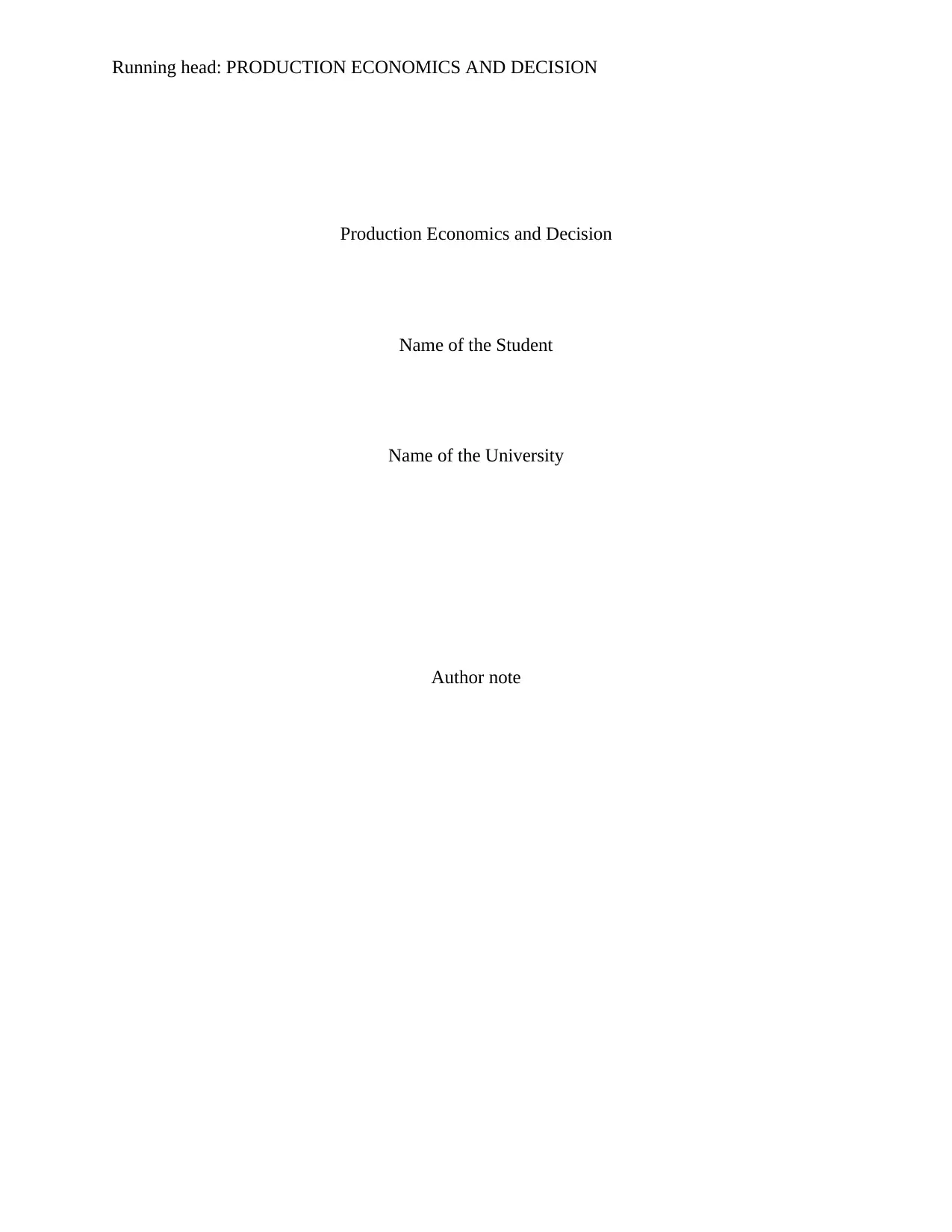
Running head: PRODUCTION ECONOMICS AND DECISION
Production Economics and Decision
Name of the Student
Name of the University
Author note
Production Economics and Decision
Name of the Student
Name of the University
Author note
Paraphrase This Document
Need a fresh take? Get an instant paraphrase of this document with our AI Paraphraser
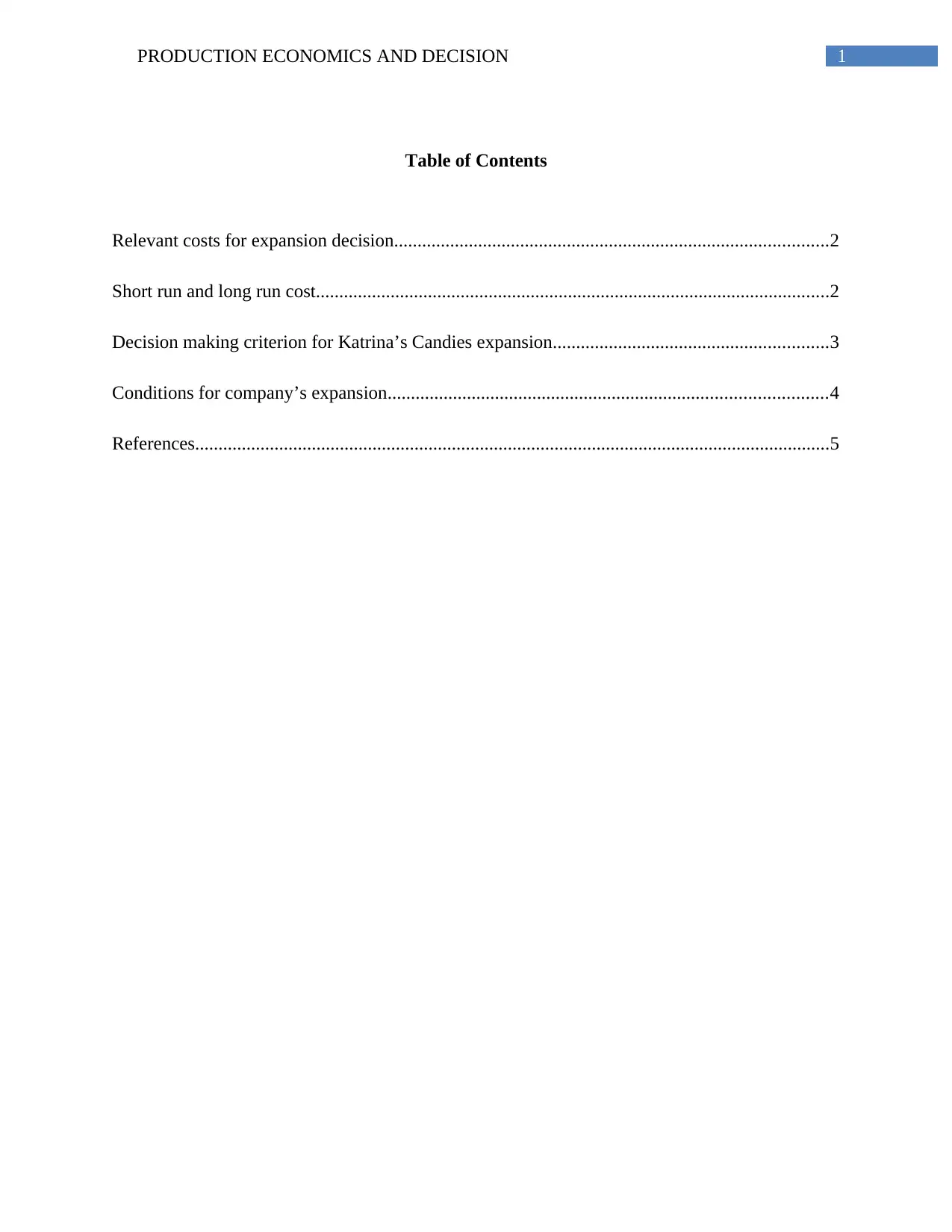
1PRODUCTION ECONOMICS AND DECISION
Table of Contents
Relevant costs for expansion decision.............................................................................................2
Short run and long run cost..............................................................................................................2
Decision making criterion for Katrina’s Candies expansion...........................................................3
Conditions for company’s expansion..............................................................................................4
References........................................................................................................................................5
Table of Contents
Relevant costs for expansion decision.............................................................................................2
Short run and long run cost..............................................................................................................2
Decision making criterion for Katrina’s Candies expansion...........................................................3
Conditions for company’s expansion..............................................................................................4
References........................................................................................................................................5
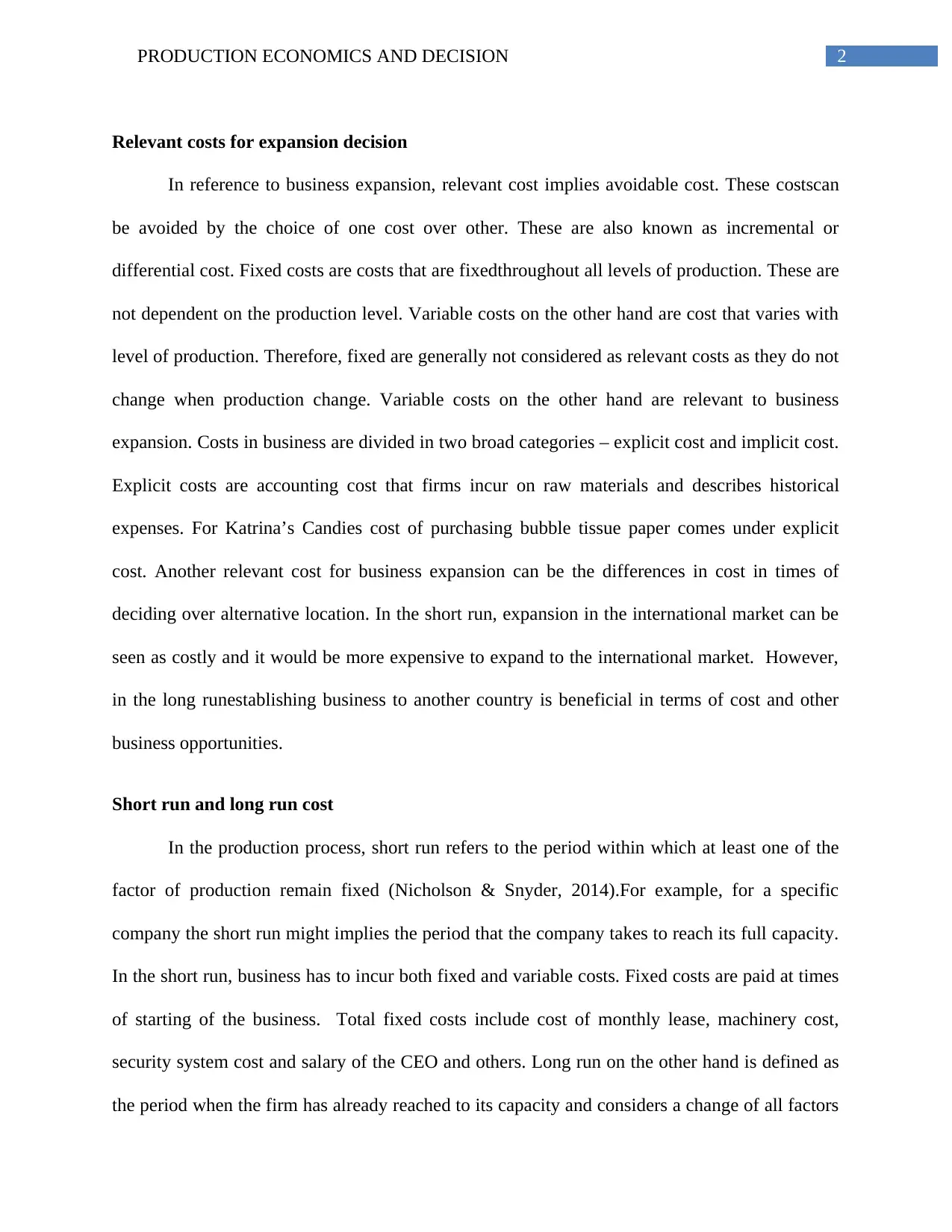
2PRODUCTION ECONOMICS AND DECISION
Relevant costs for expansion decision
In reference to business expansion, relevant cost implies avoidable cost. These costscan
be avoided by the choice of one cost over other. These are also known as incremental or
differential cost. Fixed costs are costs that are fixedthroughout all levels of production. These are
not dependent on the production level. Variable costs on the other hand are cost that varies with
level of production. Therefore, fixed are generally not considered as relevant costs as they do not
change when production change. Variable costs on the other hand are relevant to business
expansion. Costs in business are divided in two broad categories – explicit cost and implicit cost.
Explicit costs are accounting cost that firms incur on raw materials and describes historical
expenses. For Katrina’s Candies cost of purchasing bubble tissue paper comes under explicit
cost. Another relevant cost for business expansion can be the differences in cost in times of
deciding over alternative location. In the short run, expansion in the international market can be
seen as costly and it would be more expensive to expand to the international market. However,
in the long runestablishing business to another country is beneficial in terms of cost and other
business opportunities.
Short run and long run cost
In the production process, short run refers to the period within which at least one of the
factor of production remain fixed (Nicholson & Snyder, 2014).For example, for a specific
company the short run might implies the period that the company takes to reach its full capacity.
In the short run, business has to incur both fixed and variable costs. Fixed costs are paid at times
of starting of the business. Total fixed costs include cost of monthly lease, machinery cost,
security system cost and salary of the CEO and others. Long run on the other hand is defined as
the period when the firm has already reached to its capacity and considers a change of all factors
Relevant costs for expansion decision
In reference to business expansion, relevant cost implies avoidable cost. These costscan
be avoided by the choice of one cost over other. These are also known as incremental or
differential cost. Fixed costs are costs that are fixedthroughout all levels of production. These are
not dependent on the production level. Variable costs on the other hand are cost that varies with
level of production. Therefore, fixed are generally not considered as relevant costs as they do not
change when production change. Variable costs on the other hand are relevant to business
expansion. Costs in business are divided in two broad categories – explicit cost and implicit cost.
Explicit costs are accounting cost that firms incur on raw materials and describes historical
expenses. For Katrina’s Candies cost of purchasing bubble tissue paper comes under explicit
cost. Another relevant cost for business expansion can be the differences in cost in times of
deciding over alternative location. In the short run, expansion in the international market can be
seen as costly and it would be more expensive to expand to the international market. However,
in the long runestablishing business to another country is beneficial in terms of cost and other
business opportunities.
Short run and long run cost
In the production process, short run refers to the period within which at least one of the
factor of production remain fixed (Nicholson & Snyder, 2014).For example, for a specific
company the short run might implies the period that the company takes to reach its full capacity.
In the short run, business has to incur both fixed and variable costs. Fixed costs are paid at times
of starting of the business. Total fixed costs include cost of monthly lease, machinery cost,
security system cost and salary of the CEO and others. Long run on the other hand is defined as
the period when the firm has already reached to its capacity and considers a change of all factors
⊘ This is a preview!⊘
Do you want full access?
Subscribe today to unlock all pages.

Trusted by 1+ million students worldwide

3PRODUCTION ECONOMICS AND DECISION
of production. All the costs in the long-run are variable in nature and depend on the scale of
production.
Decision making criterion for Katrina’s Candies expansion
The expansion decision of Katrina Candies in the international market involves costs.
The costs can be considered both in the short run and in the long term. The short run cost of
expansion include the cost of managing current capital resources. The additional cost that the
company has to incur is the increased payroll output cost, additional marketing cost to fulfill
demand in the international market. There will be additional cost of establishing contracts with
infrastructures, vendors and communications. The expansion decision also involves implicit cost
as well. If Katrina Candies expands in the international market then at least one of the investment
projects needs to be sacrificed. The gains from the project given up is the implicit cost of the
decision. While taking the expansion decision analysis should be made on expected return or
profit that Katrina is going to receive from the expansion. Profit is obtained from total revenue
less total cost. The total costs include both explicit cost and implicit cost. The positive result
means more than normal profit and a result equals zero means just normal profit. A negative
result implies loss. The expansion of Katrina Candies include use of current resources of the firm
such as managers, specialist for chocolate recipe and one or two manufacturing teams. The
opportunity cost is the return from venturing in some other industry such as pastry industry.
The Katrina Candies should considerexpansion of business wen revenue earned from the
project is sufficient to cover explicit and implicit costs. When total revenue covers all the costs
then it is profitable to expand in the international market.
of production. All the costs in the long-run are variable in nature and depend on the scale of
production.
Decision making criterion for Katrina’s Candies expansion
The expansion decision of Katrina Candies in the international market involves costs.
The costs can be considered both in the short run and in the long term. The short run cost of
expansion include the cost of managing current capital resources. The additional cost that the
company has to incur is the increased payroll output cost, additional marketing cost to fulfill
demand in the international market. There will be additional cost of establishing contracts with
infrastructures, vendors and communications. The expansion decision also involves implicit cost
as well. If Katrina Candies expands in the international market then at least one of the investment
projects needs to be sacrificed. The gains from the project given up is the implicit cost of the
decision. While taking the expansion decision analysis should be made on expected return or
profit that Katrina is going to receive from the expansion. Profit is obtained from total revenue
less total cost. The total costs include both explicit cost and implicit cost. The positive result
means more than normal profit and a result equals zero means just normal profit. A negative
result implies loss. The expansion of Katrina Candies include use of current resources of the firm
such as managers, specialist for chocolate recipe and one or two manufacturing teams. The
opportunity cost is the return from venturing in some other industry such as pastry industry.
The Katrina Candies should considerexpansion of business wen revenue earned from the
project is sufficient to cover explicit and implicit costs. When total revenue covers all the costs
then it is profitable to expand in the international market.
Paraphrase This Document
Need a fresh take? Get an instant paraphrase of this document with our AI Paraphraser
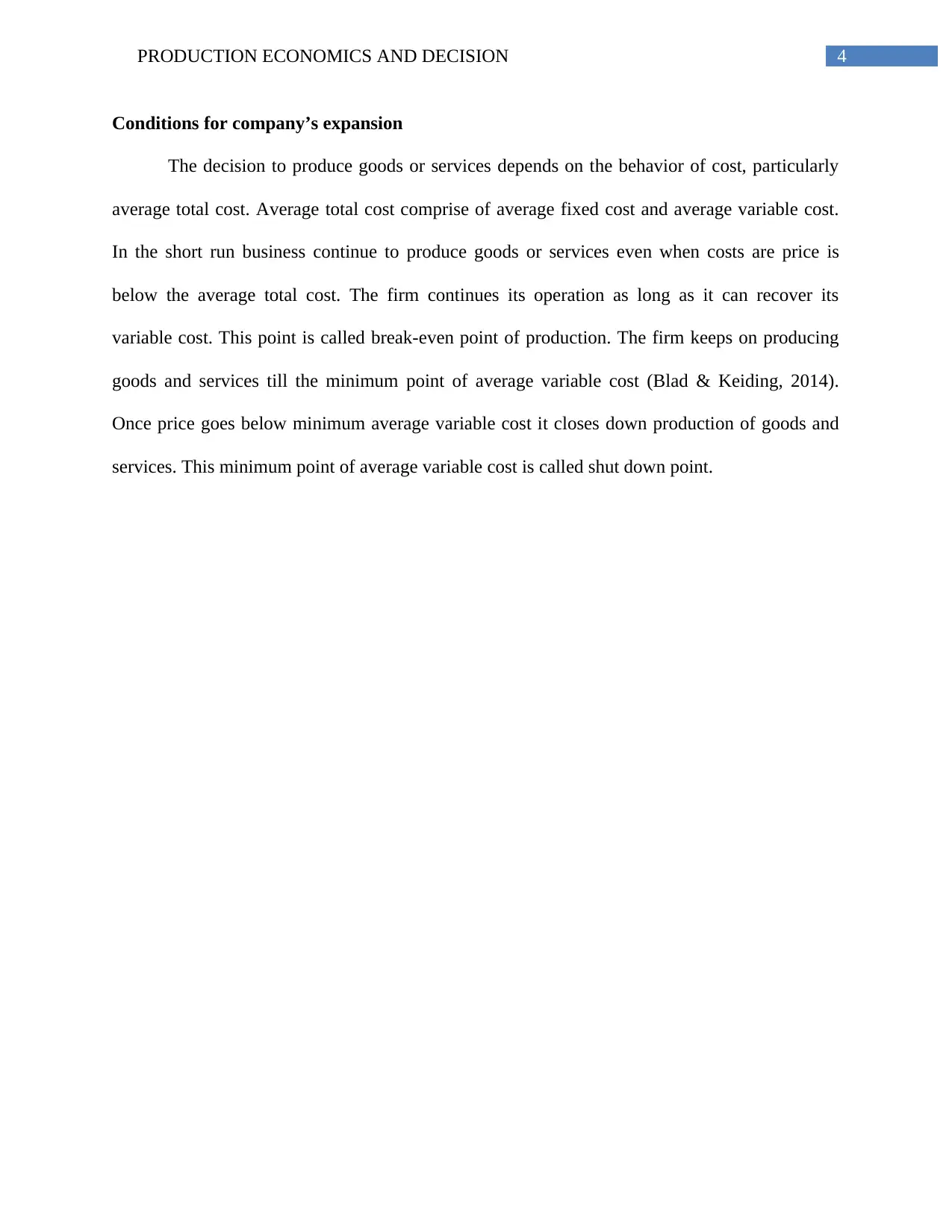
4PRODUCTION ECONOMICS AND DECISION
Conditions for company’s expansion
The decision to produce goods or services depends on the behavior of cost, particularly
average total cost. Average total cost comprise of average fixed cost and average variable cost.
In the short run business continue to produce goods or services even when costs are price is
below the average total cost. The firm continues its operation as long as it can recover its
variable cost. This point is called break-even point of production. The firm keeps on producing
goods and services till the minimum point of average variable cost (Blad & Keiding, 2014).
Once price goes below minimum average variable cost it closes down production of goods and
services. This minimum point of average variable cost is called shut down point.
Conditions for company’s expansion
The decision to produce goods or services depends on the behavior of cost, particularly
average total cost. Average total cost comprise of average fixed cost and average variable cost.
In the short run business continue to produce goods or services even when costs are price is
below the average total cost. The firm continues its operation as long as it can recover its
variable cost. This point is called break-even point of production. The firm keeps on producing
goods and services till the minimum point of average variable cost (Blad & Keiding, 2014).
Once price goes below minimum average variable cost it closes down production of goods and
services. This minimum point of average variable cost is called shut down point.
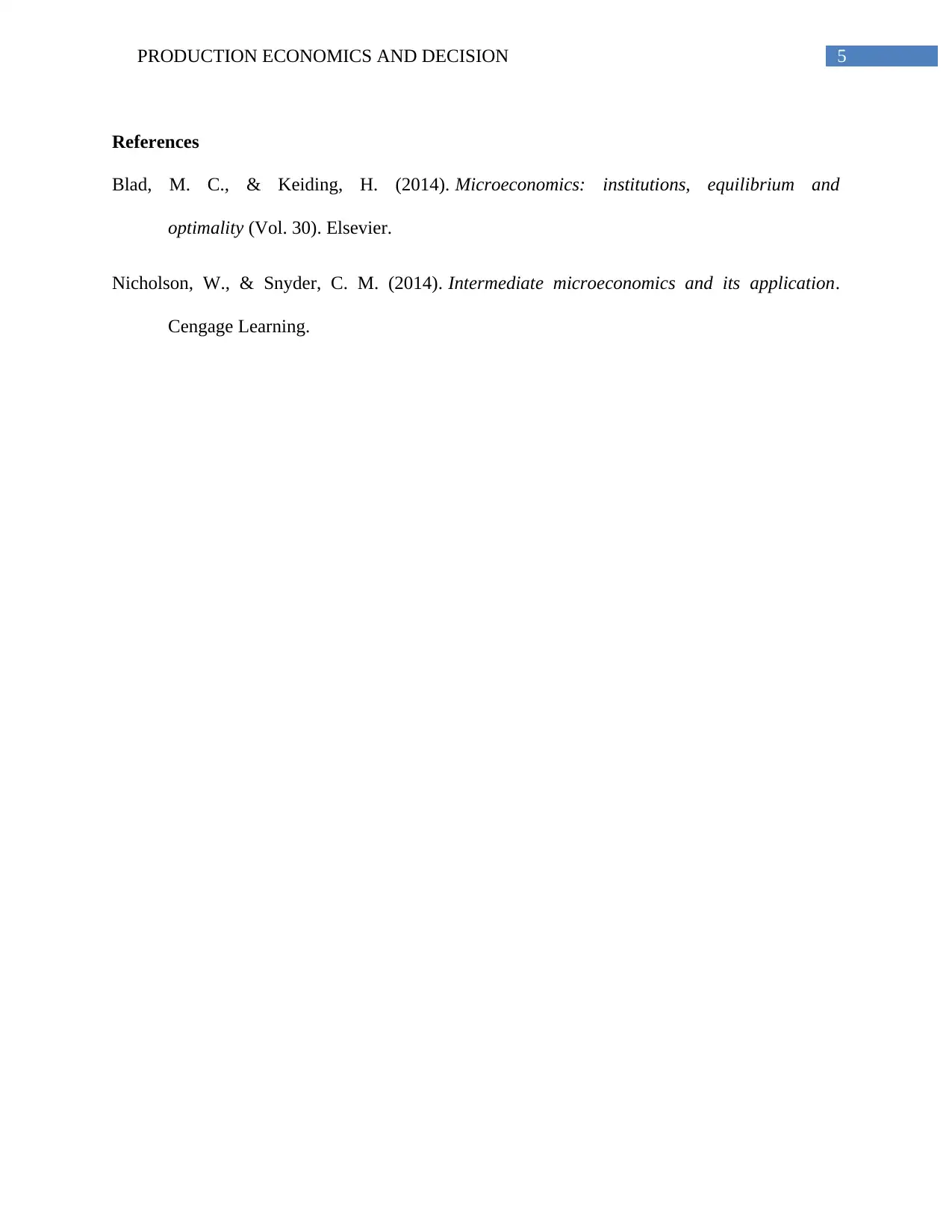
5PRODUCTION ECONOMICS AND DECISION
References
Blad, M. C., & Keiding, H. (2014). Microeconomics: institutions, equilibrium and
optimality (Vol. 30). Elsevier.
Nicholson, W., & Snyder, C. M. (2014). Intermediate microeconomics and its application.
Cengage Learning.
References
Blad, M. C., & Keiding, H. (2014). Microeconomics: institutions, equilibrium and
optimality (Vol. 30). Elsevier.
Nicholson, W., & Snyder, C. M. (2014). Intermediate microeconomics and its application.
Cengage Learning.
⊘ This is a preview!⊘
Do you want full access?
Subscribe today to unlock all pages.

Trusted by 1+ million students worldwide
1 out of 6
Related Documents
Your All-in-One AI-Powered Toolkit for Academic Success.
+13062052269
info@desklib.com
Available 24*7 on WhatsApp / Email
![[object Object]](/_next/static/media/star-bottom.7253800d.svg)
Unlock your academic potential
Copyright © 2020–2025 A2Z Services. All Rights Reserved. Developed and managed by ZUCOL.





